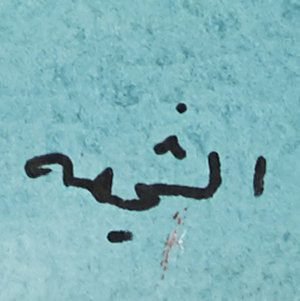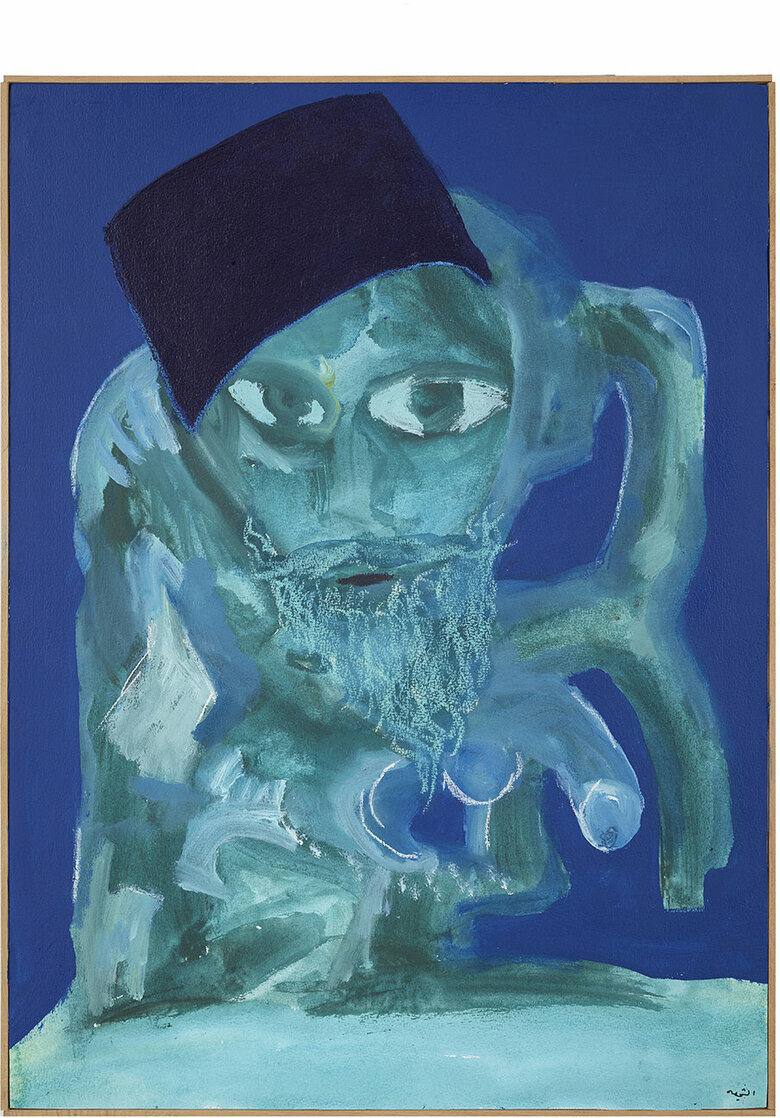Born in Beirut, Lebanon, in 1960, Fadi El Chamaa belongs to a family of merchants who enjoyed cultural and artistic endeavors in their free time.[1]EL Chamaa's father was an amateur photographer,...


FADI EL CHAMAA, Lebanon (1960)
Bio
Written by LIAM SIBAI & WAFA ROZ
Born in Beirut, Lebanon, in 1960, Fadi El Chamaa belongs to a family of merchants who enjoyed cultural and artistic endeavors in their free time.[1]EL Chamaa's father was an amateur photographer, and his mother was a porcelain painter.[2] Fadi's cousin, Marwan Chamaa, is also a contemporary visual artist. This environment inspired and informed the self-taught artist Fadi El Chamaa. As a child, Fadi El Chamaa had a stutter that kept him from communicating correctly at school and, hence, from excelling. He attended Collège des Mont La Salle in Ain Saadé but dropped out of high school in 1979, never graduating. However, the artist spent much of his childhood reading books.
El Chamaa’s academic shortcomings made him dedicate his time to art. He took up his father’s photography practice, spending much of his teens in a dark room developing black-and-white photographs. By age 21, however, El Chamaa grew tired of greyscale photography and started painting with colorful pastels onto developed photographs. Eventually, EL Chamaa drifted into a purely painterly practice. After years of refining his painting practice, the artist participated in the 1993 Salon D’Automne, the yearly group exhibition held at the Sursock Museum in Beirut. This was El Chamaa’s first institutional display of his artwork. He would go on to participate in the coveted show in 1994 and 1995. Furthermore, in 1995, El Chamaa held his first solo show at Rochane Gallery in Beirut.
Though he had become a well-known visual artist, El Chamaa had to pursue a career in advertising to make ends meet. He began working as a copywriter in 1997 and continued until 1999. As part of his job, El Chamaa traveled to most Arab world cities, including Beirut, Damascus, Doha, Khobar, Manama, Cairo, Riyadh, and Casablanca. During his stay in different Arab cities, El Chamaa worked on portraits of people from various communities. Inspired by the diverse social, ethnic, and religious groups in the Arab world, the artist investigated the cultural heritage of several countries through their people. By depicting representative and symbolic portraits, El Chamaa epitomized a whole culture.
One such work by El Chamaa is The Ghost of Ahmad Pasha, 2018, part of the Ramzi and Saeda Dalloul Art Foundation (DAF) in Beirut. Painted mostly in turquoise blue, the painting depicts Ahmad Pasha al-Jazzar, a political figure in the Ottoman Empire. Originally from Bosnia, Ahmad Pasha al-Jazzar was born Ahmad Pervan (c.1720-1804); he was an Acre-based Ottoman Governor of Sidon and Damascus Eyalet simultaneously during 1776 and 1804. Ahmed Pasha gained the epithet (al-Jazzar), which translates to ‘the butcher,’ after he ruthlessly slaughtered a group of Bedouin tribesmen as revenge for his master's death. He later became a chief enforcer and assassin for Ali Bey al-Kabir, Egypt's practical ruler back then.
Ahmad Pasha is depicted wearing a black Fez, a significant headdress affiliated with Ottoman rule, worn as early as the 1460s; it was then adopted by Muslim and non-Muslim noblemen. Initially, the Fez was a brimless red, black, or white bonnet over which a turban was wrapped. Later, the turban was removed, and the bonnet - limited to the color red - was shortened;[3]it made it a practical headdress during Muslim men’s prayers. Also known as the Tarboush in Arabic, the Fez was named after the city of Fez in Morocco, where red crimson berry was outsourced to dye the felt fabric it was made of. In 1827, Sultan Mahmud II (1808-1839) mandated his army to wear a black uniform and the Fez. In 1925, Moustafa Kemal Atatürk, Turkey’s 1st president, banned the Fez as part of his initiated political and religious reforms.[4]
In the painting, Ahmad Pasha Al-Jazzar’s face seems deformed, and his figure is dwarfed, a contrasting depiction of an eerie tyrannical character and one that is belittled. The artist emphasized his complex, imposing facial features with round, comprehensive, piercing eyes and a remarkable white beard with long hair strands. Another notable element of this painting is Ahmad Pasha’s male sexual organ, an odd addition to the painting’s mise en scène. It symbolizes Ahmad Pasha Al–Jazzar's phallic power. In context, the painting addresses the tyrannical rule of the Ottomans in today's Lebanon and Syria. It reflects the horror the artist's ancestors felt toward their Ottoman conquerors.[5]Yet, by portraying the Pasha's deformed body, the painting critiques the vulgarity and distortion inherent in imperial rulers. Top of Form
Moreover, Fadi El Chamaa was interested in the relationship between humans, nature, and animals. He sought a universal world that transcends cultural and political specificities. Relating figurative portraiture to landscape depictions, El Chamaa once said: “All my landscapes are portraits, and all my portraits are landscapes.” El Chamaa painted portraits of anonymous, faceless, often headless human beings, such as in his body of work: Sentiment d’Incomplétude 1, 2, and 3, created in 2020, where the characters’ heads take the shape of diverging tree branches. Another example is his series of paintings titled Fuqa’a, 2023, which means air bubble in Arabic. Each painting features abstracted figures with colorful translucent-like bubbles that seem like floating clouds.
El Chamaa's recent landscape paintings reflect his concern with transparency and translucency. In one of his latest paintings titled View from the Studio, 2023[6], El Chamaa depicts the scenery overlooking his Studio in Baabda, Lebanon. The painting, dominant in a green monochromatic palette, features an abstract landscape executed with watercolor and textured material. It shows patches of green paint that indicate a meadow with grass or vegetation and blue strokes that insinuate water or clouds. Another example is Sannine Snowy Peak, 2023[7], a painting featuring the famous snowcapped Sannine mountain in Lebanon[8]. It also shows an abstract rendition of water, trees, and a suspended bird-painted fuchsia; it hovers around a large translucent sun, surrounded by other semi-transparent circular bodies. This translucent air-bubble effect is set against intersecting and overlapping colorful abstract shapes. The artist refers to such works as "Emotional Landscapes."[9], inspired by the art of German modernist painter Paul Klee.
El Chamaa pays careful attention to the symbolic nature of color and the relationship between different hues. He has written on the theory of color in some volumes of his series of publications titled What is[10].This is evident in View from the Studio, where he paints a thin layer of airsoft, bright blue depicting an air bubble against a dense, darker shade of green reminiscent of thick, impenetrable, earthy ground. Here, he uses color to portray a dual feeling of lightness and rigidity.
El Chamaa still lives and works in his Studio in Baabdat, Lebanon. Like when he was a child, he never ceased experimenting with different forms of painting, daily producing new hypnotic works to be viewed by the public firsthand.
Edited by Wafa Roz
Notes:
[1] Fadi El Chamaa and Liam Sibai, Interview with Fadi El Chamaa, other, The Dalloul Art Foundation, n.d.
[2] Fadi El Chamaa, “What Is,” Fadi El Chamaa, September 14, 2022, fadielchamaa.com
[5] “The Ghost of Ahmad Bacha by Fadi El Chamaa,” Dalloul Art Foundation, accessed December 27, 2023, dafbeirut.org
[6] Fadi El Chamaa, “View From The Studio,” Fadi El Chamaa, November 22, 2023, fadielchamaa.com
[7] Fadi El Chamaa, “Sannine Snowy Peak,” Fadi El Chamaa, November 22, 2023, fadielchamaa.com
[8] “Mount Sannine,” My Lebanon Guide, accessed January 18, 2024, mylebanonguide.com
[9] Fadi El Chamaa and Liam Sibai, Interview with Fadi El Chamaa, other, The Dalloul Art Foundation, n.d.
[10] Fadi El Chamaa, “What Is,” Fadi El Chamaa, September 14, 2022, fadielchamaa.com
Bibliography
Anderson, Jacob. “Paul Klee: Illuminating the Spectrum of Artistic Expression: 1st Art Gallery.” 1st handmade portraits and reproductions, August 30, 2023. www.1st-art-gallery.com
Chamaa, Fadi El. “Lebanese Visual Artist- Fadi ElChamaa- About.” Fadi El Chamaa, November 30, 2023. fadielchamaa.com
Chamaa, Fadi El. “Sannine Snowy Peak.” Fadi El Chamaa, November 22, 2023. fadielchamaa.com
Chamaa, Fadi El. “View From The Studio.” Fadi El Chamaa, November 22, 2023. fadielchamaa.com
Chamaa, Fadi El. “What Is.” Fadi El Chamaa, September 14, 2022. fadielchamaa.com
El Chamaa, Fadi, and Liam Sibai. Interview with Fadi El Chamaa. Other. The Dalloul Art Foundation, n.d.
“Fadi El Chamaa: Fuqa’a.” Mutual Art, 2022. www.mutualart.com
“Fadi El Chamaa : Artist Bio & Art For Sale.” Artscoops. Accessed December 27, 2023. artscoops.com
“The Ghost of Ahmad Bacha by Fadi El Chamaa.” Dalloul Art Foundation. Accessed December 27, 2023. www.dafbeirut.org
“Mount Sannine.” My Lebanon Guide. Accessed January 18, 2024. mylebanonguide.com
CV
Selected Solo Exhibitions
2023
The Disappearing Act, Lynn Modallal Galery, Beirut, Lebanon
2022
Fuqa’a, Galerie Janine Rubeiz, Beirut, Lebanon
2020
Mamnou3 El Tehzib, SWTE, Beirut, Lebanon
2019
And Tomorrow Who Am I?, Artlab Gallery, Beirut Lebanon
2016
Deviations, Galleria Soul Egypt, El Gouna, Egypt
2011
Transformations, Joanna Seikali Gallery, Beirut, Lebanon
1997
Drawings and Paintings, Rochan Gallery, Beirut Lebanon
Group Exhibitions
2023
La Tête Dans Les Nuages, Walls House Of Art, Abidjan, Côte d’Ivoire
Not Today, Modallal Galery, Beirut, Lebanon
2022
Electicism, Dune Art Station Dubai, United Arab Emirates
True Colors, Fltrd Gallery, Dubai, United Arab Emirates
2021
Madman, Galerie Beibai, Shanghai, China
True Colors, Fltrd DIFC Dubai, Dubai, United Arab Emirates
Wajihāt, Janine Rubeiz Gallery, Beirut, Lebanon
2020
The Collective, Galerie BeiBei, Shanghai, China
2019
Raw, KAF Contemporary Art Gallery, Beirut, Lebanon
Peace of Liberty, Gebran Tueni Foundation, Beirut, Lebanon
Sleeping With The Enemy, KAF Contemporary Art Gallery, Beirut, Lebanon
The Collective, KAF Contemporary Art Gallery, Beirut, Lebanon
HOC EVA, Eve Liebe Gallery, London, United Kingdom
2018
From the Artist’s Studio, KAF Contemporary Art Gallery, Beirut, Lebanon
2016
ElChamaa Vs Khawam, Rochane Gallery, Beirut, Lebanon
Utopian Identity, Gallery 59, Paris, France
2015
Strange Fruits, Wood of Joy, Baabdat, Lebanon
2012
Mapping Soul, Gallery 59, Paris, France
1996
Salon D’automne, Nicolas Ibrahim Sursock Museum, Beirut, Lebanon
1995
Salon D’automne, Nicolas Ibrahim Sursock Museum, Beirut, Lebanon
Yarzeh, Yarzeh Art Gallery, Yarzeh, Lebanon
1994
Salon D’automne, Nicolas Ibrahim Sursock Museum, Beirut, Lebanon
1993
Salon D’automne, Nicolas Ibrahim Sursock Museum, Beirut, Lebanon
Affiliations & Memberships
2019
Co-founder of The Sleeping Productions, Beirut, Lebanon
Collections
Ramzi and Saeda Dalloul Art Foundation
Press
daily star transformations.pdf
El-Chamaa vs Khawam _ divergences et cohérence... - Quentin BEAUREPAIRE - L'Orient-Le Jour.pdf
الكل للواحد والواحد للكل - Features - Atassi Foundation (1).pdf
FADI EL CHAMAA Artwork
Become a Member
Join us in our endless discovery of modern and contemporary Arab art
Become a Member
Get updates from DAF
Follow Artists
Save your favourite Artworks
Share your perspectives on Artworks
Be part of our community
It's Free!
We value your privacy
TermsCookiesPrivacy Policies
Become a Member
Get updates from DAF
Follow Artists
Save your favourite Artworks
Share your perspectives on Artworks
Be part of our community
It's Free!
We value your privacy
TermsCookiesPrivacy Policies
Become a Member
Get updates from DAF
Follow Artists
Save your favourite Artworks
Share your perspectives on Artworks
Be part of our community
It's Free!
We value your privacy
TermsCookiesPrivacy Policies
Welcome to the Dalloul Art Foundation
Thank you for joining our community
If you have entered your email to become a member of the Dalloul Art Foundation, please click the button below to confirm your email and agree to our Terms, Cookie & Privacy policies.
We value your privacy, see how
Become a Member
Get updates from DAF
Follow Artists
Save your favourite Artworks
Share your perspectives on Artworks
Be part of our community
It's Free!
We value your privacy
TermsCookiesPrivacy Policies




